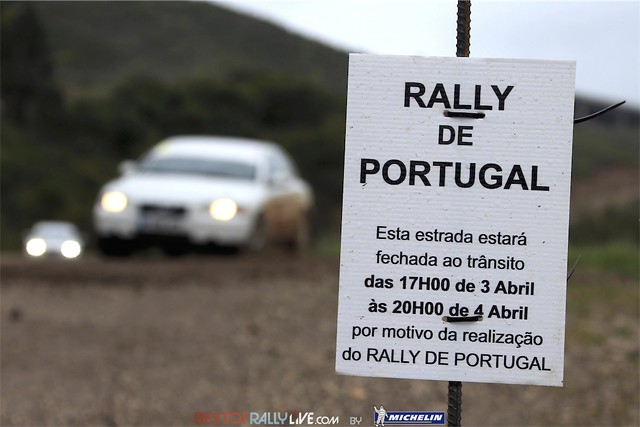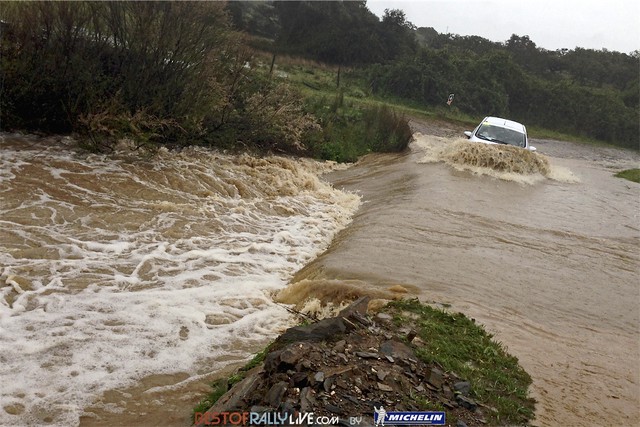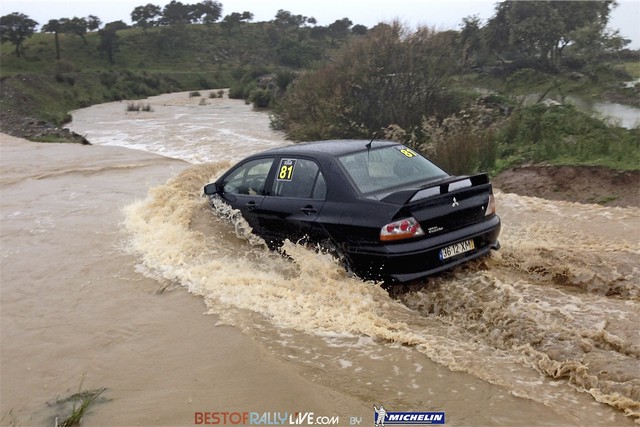mercredi 2 avril 2014
Shakedown honours for Latvala / A Latvala le Shakedown

The fastest time on this afternoon’s shakedown was posted by Jari-Matti Latvala (VW/Michelin), ahead of Henning Solberg and Sébastien Ogier. Next on the programme is Thursday afternoon’s start ceremony in Estoril, followed by the traditional super-special in the centre of Lisbon.
The WRC’s Priority 1 drivers kicked off the 2014 Rally de Portugal with this afternoon’s 4.98km shakedown test near Vale do Judeu. The best time on the same stage two years ago was 3m1.6s (Dani Sordo), while Latvala topped the order in 2013 with a 3m1.8s.
The times were much slower today, however, due to the muddy conditions resulting from recent heavy rain. The Finn posted his best effort (3m5.2s) at second attempt, quite late on, with his Polo R WRC on soft-compound Michelin ‘S2’ tyres. Before him, Solberg (Ford) had led the field with a 3m6s on his fourth run. This year, only two passes are mandatory for the Priority 1 and 2 drivers, compared with four previously.
Also on soft tyres, Ogier posted a 3m7.1s on his second run, ahead of Sordo (Hyundai i20 WRC, 3m7.8s) who went 8.5 seconds better when he switched from hard to soft rubber.
Mikko Hirvonen (Ford) was fifth (3m8.3s), ahead of Hyundai’s Juha Hanninen (3m8.4s) and Thierry Neuville (3min08s5) who was the only driver to complete three passes on hard tyres. Mads Ostberg (Citroën) was ninth, behind Robert Kubica (Ford).
The new measures voted in recently by the FIA Rally Commissions will apply this weekend: Priority 1 and 2 drivers who re-start under the Rally2 ruling will be first on the road for the following leg, while all drivers who re-start will be eligible for Power Stage points, even those who retire on the Saturday. A five-minute penalty will be incurred for failing to contest a super-special.
Jari-Matti Latvala (VW/Michelin) a réalisé le meilleur chrono du Shakedown devant Henning Solberg et Sébastien Ogier. Demain, la cérémonie de départ se déroulera à Estoril en début d’après-midi avant la traditionnelle Superspéciale de Lisbonne.

Les pilotes prioritaires 1 ont débuté leur Rallye du Portugal 2014 cet après-midi par le Shakedown long de 4,98 km organisé à Vale do Judeu. L’an passé, sur ce même parcours, Dani Sordo avait réalisé le meilleur temps en 3min01s6 et il y a deux ans, c’est Jari-Matti Latvala qui s’était imposé en 3min01s8.
C’est allé beaucoup moins vite aujourd’hui, à cause des pistes rendues boueuses par les pluies passées. Chaussé de pneus S2 soft, Jari-Matti Latvala a signé le meilleur temps sur sa Polo R WRC, en 3min05s2, lors de son second passage réalisé tardivement. Jusque-là, Henning Solberg (Ford) détenait le temps de référence (3min06s) établi à son 4e passage. Désormais, seuls deux passages sont obligatoires au Shakedown (contre quatre auparavant) pour les pilotes P1 et P2.
En pneus Michelin soft, Sébastien Ogier a réalisé 3min07s1 à son 2e et dernier tour, devant Dani Sordo (Hyundai i20 WRC, 3min07s8) qui a gagné 8.5 secondes en passant de pneus hard à soft.
Mikko Hirvonen (Ford) a réalisé le 5e meilleur chrono (3min08s3) devant les Hyundai d’Hanninen (3min08s4) et de Neuville (3min08s5), le seul à avoir bouclé trois passages en pneus hard. Mads Ostberg (Citroën) n’a réalisé que le 9e temps derrière Robert Kubica (Ford).
Les mesures récemment votées par la Commission des rallyes s’appliquent dès ce week-end : les pilotes prioritaires P1 et P2 en Rally2 repartiront en 1ers sur la route, tous les pilotes sont éligibles pour marquer des points à la Power Stage (même ceux ayant abandonné le samedi), une pénalité de 5 minutes est appliquée par Superspéciale manquée.
After the rain the sun…/ La pluie et le beau temps…
The torrential downpours that have fallen over Portugal’s Algarve region in recent days were bad enough to upset recce plans. The sun has returned, however, in time for this afternoon’s shakedown.
WRC observers will remember that the Rally de Portugal was badly affected by heavy rain in 2001 and 2012, but why does it rain so often in this part of the world? That was a question we couldn’t help asking ourselves when shower after shower blew over us as we drove along the windswept A2 motorway. There were flooded fields all around and the cork oak trees have doubled in volume…
During recce, competitors reported torrents of mud across the road and the timetable was severely troubled, although the crews were finally able to complete their notes of this week’s 15 ‘real’ stages.
Thankfully, the weather has already started to improve and the cars headed off for this afternoon’s shakedown in glorious sunshine. If the hot spell lasts, and if it stays windy, the conditions will probably dry very quickly, but a certain amount of mud is sure to linger.
The Priority 1 drivers have a total allocation of 29 Michelin Latitude Cross H2 (hard compound) and 30 Latitude Cross S2 (soft) tyres for the rally and shakedown, while their WRC-2 colleagues have 24 H2s and 16 S2s. The Portuguese stages are notoriously abrasive, so the hard compound promises to be the predominant choice, although Sébastien Ogier ran a combination of soft and hard tyres at the same time during the early part of the 2013 rally.
Like every year since 2007, the Vodafone Rally de Portugal’s service park uses the car park of the Estadio de Algarve stadium which was built exactly 10 years ago for the Euro 2004 soccer tournament. With all the top teams’ motorhomes and hospitality facilities gathered together for the first time this year (from Citroën-Total Abu Dhabi’s ‘Wave’, to the M-Sport and Hyundai Motorsport buildings and Volkswagen’s paddock), it is a truly impressive sight!
Il a beaucoup, mais alors beaucoup plu sur le Portugal et l’Algarve ces derniers jours, au point de perturber les reconnaissances. Mais le soleil est revenu cet après-midi pour le Shakedown.

2001, 2012… Mais pourquoi pleut-il toujours au Rallye du Portugal ? C’est la question que nous nous posions ce matin en chevauchant l’autoroute A2 balayée par de violentes averses. Partout des champs inondés. Même les chênes-liège ont doublé de volume…
Dans certaines spéciales, les pilotes ont carrément dû traverser des torrents de boue. Le planning des reconnaissances a été perturbé, mais finalement, tous les équipages ont pu prendre en notes les 15 « vraies » spéciales de l’édition 2014.
La météo devrait s’améliorer à partir de cet après-midi. Les WRC ont d’ailleurs pris la direction du Shakedown sous un chaud soleil. Si le beau temps se maintient, et avec le souffle d’Eole, les spéciales devraient sécher rapidement, même si quelques passages resteront sans doute boueux.
Les pilotes prioritaires 1 dispose de 29 pneumatiques Michelin Latitude Cross H2 (hard) et de 30 pneus Latitude Cross S2 (soft) pour le rallye et le Shakedown. En WRC-2, les quotas sont de 24 hard et 16 soft.
Les spéciales portugaises étant très abrasives, le choix devrait se porter principalement sur la gomme hard. Mais on se souvient que l’an passé, Sébastien Ogier avait opté pour un panachage soft/hard en début de rallye.
Comme chaque année depuis 2007, le parc d’assistance du Vodafone Rally de Portugal est installé sur le parking de l’Estadio de Algarve, un stade construit il y a pile dix ans pour l’Euro de football. Le parc a d’ailleurs fière allure avec les tous les motor-homes réunis pour la 1ère fois de la saison : la Wave de Citroën-Total Abu Dhabi, les immeubles M-Sport et Hyundai Motorsport, le paddock Volkswagen…
Edwin Europe 'NORTH OF THE SOUTH'
For Spring / Summer 2014, the FURTHER Crew made the trip to Serra d'Arga, north of Porto along with some vintage Hondas, a Norton, a temperamental Citroen DS and a couple of Willy's Jeeps for a few days in the sun...
Edwin Europe 'NORTH OF THE SOUTH' - Spring / Summer 2014 from Edwin Europe on Vimeo.
Edwin Europe 'NORTH OF THE SOUTH' - Spring / Summer 2014 from Edwin Europe on Vimeo.
Après plusieurs échecs, découvrez comment Jarvis s’est relevé pour mieux l’emporter à Erzberg.
Le n°1 mondial en hard enduro, le Britannique Graham Jarvis, entretient une relation compliquée avec l’Erzberg Rodeo. À chaque fois aux avant-postes, la victoire lui a pourtant échappé à plusieurs reprises, avec une certaine dose de frustration à la clé.
En effet, trois années durant, lors des éditions 2010 à 2012, Jarvis a écopé d’une disqualification pour avoir raté des checkpoints obligatoires lors du Red Bull Hare Scramble, la finale emblématique de l’Erzberg Rodeo, un parcours du combattant de quatre heures au guidon d’une moto.
Dans ces bois denses et par visibilité réduite en raison du brouillard, il est vite arrivé de manquer un de ces points de passage. Mais la disqualification fut d’autant plus douloureuse à encaisser pour Jarvis qu’il ne l’apprit qu’une fois la ligne d’arrivée franchie…. en première position, comme c’est arrivé en 2011 et 2012.
Dans ces bois denses et par visibilité réduite en raison du brouillard, il est vite arrivé de manquer un de ces points de passage. Mais la disqualification fut d’autant plus douloureuse à encaisser pour Jarvis qu’il ne l’apprit qu’une fois la ligne d’arrivée franchie…. en première position, comme c’est arrivé en 2011 et 2012.
Preuve de la trempe de l’enduriste, il est revenu encore plus déterminé l’an passé à Erzberg. Malgré un départ en seconde ligne seulement après des qualifications moyennes dans ces conditions difficiles, Jarvis est remonté sur les 50 pilotes qui le précédaient et, au terme des quatre heures de course, le Britannique terminait grand vainqueur du Géant de Fer, devantAndreas Lettenbichler et Alfredo Gomez.
Dans cette vidéo, Graham Jarvis est rejoint par d’anciens vainqueurs de l’Erzberg Rodeo tels que Lettenbichler ou Jonny Walker et ils reviennent sur cette édition 2013. Tous évoquent le triomphe historique de Jarvis et attendent de pied ferme la remise en jeu de son titre lors de la prochaine édition 2014, le 29 mai prochain. Pour en voir davantage, jetez un œil au film “Erzberg: The Hard Way”.
Porsche 911 Carrera CS: The lost gentleman
The Porsche 911 is the most popular sports car of all time, yet there are still variants that remain elusive, such as the rare 911 Carrera 3.2 Clubsport…
At August Porsche Addiction in Belgium, there’s always something special to see, be it a 1973 2.7 RS or rare factory racing machines. But one 911 from the diverse collection is something rather unusual. At first glance it seems like an ordinary G-Series Carrera. However, that whale-tail Turbo spoiler and the unusual script emblazoned on the side have us sitting up and taking notice, as we realise it's one of the highly desirable Carrera Clubsport models…
One of just...
Like the slightly later 968 Clubsport, the 911 CS was a more extreme yet affordable version of the G-Series. Rather than concentrating on maximising performance from the engine (the redline was raised ever so slightly), Porsche put the 3.2 Carrera on a crash diet. Electrical creature comforts were mainly culled: air-conditioning, electric windows and central locking, for example – if it wasn’t absolutely necessary, it was gone. As a result, the standard car’s 1210kg kerb weight was reduced by around 50kg. It's not officially known how many were produced between 1987 and 1989, but it's thought to be only a few hundred. Unlike today, stripped-out specials often (perhaps logically) used to cost less than their full-fat counterparts and the 911 CS was some £1200 cheaper.
A pre-commercial pearl
Pierre Breda, owner of August Porsche Addiction, is one of the lucky few owners. His incredibly rare Guards Red car (most were Grand Prix White) is certainly not a museum piece, either, boasting a positively impressive 80,000km on the clock, not that you could tell from its pristine condition. The 3.2-litre six-cylinder engine purrs like a kitten, the manual 'box feels as precise as it did when it left the factory and the unique pin-striped velour seats look freshly trimmed. The Alcantara steering wheel is not original, confesses Pierre, claiming it was installed to improve the driver's grip. He kept the original, of course; not that it matters – we were already long convinced that this 911 Clubsport is something truly special.
Photos: Jan Richter
Classic Porsche 911s for sale at August Porsche Addiction (and more) can be found in the Classic Driver Market.
If Formula 1 met fighter plane
Imagine for a second that Formula 1 used fighter planes rather than single seater cars. Let me walk you through a little history…
Fast forward to 1992 and the Soviet Union has made a miraculous recovery in Formula 1 (the Hungarian Grand Prix no longer F1’s sole representation behind the Iron Curtain). Decked in the Benetton colours, as worn by the Benetton B192, the Polikarpov I-15 was a proponent of the Spanish Civil War, its B192 alter-ego making its own – arguably less significant – impression on the history books by taking a podium first time off the chocks courtesy of wing commander Michael Schumacher. Though teammate Martin ‘Lofty’ Brundle would take five podiums to the German’s four during the final eight races, it would be Schumacher who scored the car’s – and his – first victory after a dogfight at Spa-Francorchamps.
Just four years later, Schumacher would become the inimitable ‘Red Baron’ by joining Ferrari and sealing five championships on the bounce, a series of fast Fiat G55 Centauros deposing the Finnish guard, a rogue Colombian Kfir and even the Spanish Air Force’s leading aviator, Fernando ‘El Hijo’ Alonso. The F2007 Centauro that rolled out in 2007 would be the first without Schumacher’s crest on its wings, though the Prancing Horse – once the symbol of Italian air force ace Count Francesco Baracca – proved it still ruled the skies above the F1 circus by nailing victory and the championship first time out courtesy of Kimi ‘Suu Kiinni’ Raikkonen.
Germany’s influence on the skies was far from over though. From 2006 onwards, the Hunn would be led by BMW-Sauber squadron. Success proved fleeting though. Whilst the Messerschmitt Bf 109 was flown by the three top-scoring German fighter aces of the second World War, who claimed 928 victories mainly on the Eastern Front, BMW-Sauber’s F1.08 competition variant would be the squad’s sole victor in Canada. Nick Heidfeld – the Blond Knight of Germany – admirably flew Wingman a record 13 times, and even future ace Sebastian Vettel took flight for the first time with the group, though Robert Kubica would be the only pilot to earn his wings.
The heavy hitters come the end of the year would be McLaren, the Silver Arrows taking the top prize with Lewis ‘Biggles’ Hamilton in only his second year out of flight school. McLaren though, the most experienced British group in F1 history – in much the same way the Supermarine Spitfire was produced in greater numbers than any other British aircraft – would give best to an upcoming newcomer in 2009, dogged determination after years with the Italian occupying forces (namely Ross Brawn’s tenure at Ferrari) proving the key to championship glory when Brawn GP debuted on the Allied Side…
…just three years after the preceding squadron – British American Racing – took victory in Hungary (the Iron Curtain now lifted) courtesy of Jenson ‘Mad Major’ Button. In then trademark dayglow yellow colours and with goggles affixed, Button became the second British champion in succession in 2009.
And they say that the 2014 Formula 1 regulations are radical…
- Shots courtesy of Clavework Graphics
10 British speed legends from the Classic Driver Market
Britain has always been a nation of speed junkies – unless savouring an expertly made afternoon tea, of course. We’ve checked what’s currently brewing in the Classic Driver Market, and now bring you our favourite British legends of speed…
Inscription à :
Articles (Atom)


















